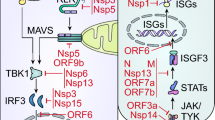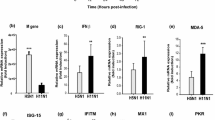Abstract
Measles virus (MeV) first infects immune cells in the respiratory tract of a human host, spreads to lymphoid organs throughout the body, and finally enters and grows in respiratory epithelial cells before being released and transmitted to the next host. Thus, efficient growth in respiratory epithelial cells is important for the person-to-person transmission of MeV. Upon viral entry, host cells detect viral nucleic acids and produce interferons (IFNs) to control viral growth. Type I (IFN-α/β) and type III (IFN-λ) IFNs have largely common induction and signaling mechanisms and stimulate expression of similar target genes but utilize distinct receptors. To determine the relative contributions of type I and type III IFNs to the control of MeV growth in epithelial cells, we examined the growth of MeV and that of its mutants lacking either type I or type III IFN receptor in the human lung epithelial cell line H358. Our results revealed that both type I and type III IFNs are required to restrict MeV growth in H358 cells and that the induction of type III as well as type I IFNs was increased in the absence of the MeV nonstructural V protein.




Similar content being viewed by others
References
Andreakos E, Salagianni M, Galani IE, Koltsida O (2017) Interferon-lambdas: front-line guardians of immunity and homeostasis in the respiratory tract. Front Immunol 8:1232
Berghall H, Siren J, Sarkar D, Julkunen I, Fisher PB, Vainionpaa R, Matikainen S (2006) The interferon-inducible RNA helicase, mda-5, is involved in measles virus-induced expression of antiviral cytokines. Microbes Infect 8:2138–2144
Brower M, Carney DN, Oie HK, Gazdar AF, Minna JD (1986) Growth of cell lines and clinical specimens of human non-small cell lung cancer in a serum-free defined medium. Cancer Res 46:798–806
Childs K, Stock N, Ross C, Andrejeva J, Hilton L, Skinner M, Randall R, Goodbourn S (2007) mda-5, but not RIG-I, is a common target for paramyxovirus V proteins. Virology 359:190–200
Cong L, Ran FA, Cox D, Lin S, Barretto R, Habib N, Hsu PD, Wu X, Jiang W, Marraffini LA, Zhang F (2013) Multiplex genome engineering using CRISPR/Cas systems. Science 339:819–823
Coughlin MM, Beck AS, Bankamp B, Rota PA (2017) Perspective on global measles epidemiology and control and the role of novel vaccination strategies. Viruses 9:11
Cuevas RA, Ghosh A, Wallerath C, Hornung V, Coyne CB, Sarkar SN (2016) MOV10 provides antiviral activity against RNA viruses by enhancing RIG-I-MAVS-independent IFN induction. J Immunol 196:3877–3886
Davis ME, Wang MK, Rennick LJ, Full F, Gableske S, Mesman AW, Gringhuis SI, Geijtenbeek TB, Duprex WP, Gack MU (2014) Antagonism of the phosphatase PP1 by the measles virus V protein is required for innate immune escape of MDA5. Cell Host Microbe 16:19–30
Frenzke M, Sawatsky B, Wong XX, Delpeut S, Mateo M, Cattaneo R, von Messling V (2013) Nectin-4-dependent measles virus spread to the cynomolgus monkey tracheal epithelium: role of infected immune cells infiltrating the lamina propria. J Virol 87:2526–2534
Galani IE, Triantafyllia V, Eleminiadou EE, Koltsida O, Stavropoulos A, Manioudaki M, Thanos D, Doyle SE, Kotenko SV, Thanopoulou K, Andreakos E (2017) Interferon-lambda mediates non-redundant front-line antiviral protection against influenza virus infection without compromising host fitness. Immunity 46(875–890):e876
Griffin DE (2013) Measles virus. In: Knipe DM, Howley PM (eds) Fields virology, 6th edn. Wolters Kluwer Health/Lippincott Williams & Wilkins Co, Philadelphia, pp 1042–1069
Hamming OJ, Terczynska-Dyla E, Vieyres G, Dijkman R, Jorgensen SE, Akhtar H, Siupka P, Pietschmann T, Thiel V, Hartmann R (2013) Interferon lambda 4 signals via the IFNlambda receptor to regulate antiviral activity against HCV and coronaviruses. EMBO J 32:3055–3065
Hashimoto K, Ono N, Tatsuo H, Minagawa H, Takeda M, Takeuchi K, Yanagi Y (2002) SLAM (CD150)-independent measles virus entry as revealed by recombinant virus expressing green fluorescent protein. J Virol 76:6743–6749
Ikegame S, Takeda M, Ohno S, Nakatsu Y, Nakanishi Y, Yanagi Y (2010) Both RIG-I and MDA5 RNA helicases contribute to the induction of alpha/beta interferon in measles virus-infected human cells. J Virol 84:372–379
Kato H, Takeuchi O, Sato S, Yoneyama M, Yamamoto M, Matsui K, Uematsu S, Jung A, Kawai T, Ishii KJ, Yamaguchi O, Otsu K, Tsujimura T, Koh CS, Reis e Sousa C, Matsuura Y, Fujita T, Akira S S (2006) Differential roles of MDA5 and RIG-I helicases in the recognition of RNA viruses. Nature 441:101–105
Kawai T, Akira S (2008) Toll-like receptor and RIG-I-like receptor signaling. Ann N Y Acad Sci 1143:1–20
Kotenko SV, Gallagher G, Baurin VV, Lewis-Antes A, Shen M, Shah NK, Langer JA, Sheikh F, Dickensheets H, Donnelly RP (2003) IFN-lambdas mediate antiviral protection through a distinct class II cytokine receptor complex. Nat Immunol 4:69–77
Lazear HM, Nice TJ, Diamond MS (2015) Interferon-lambda: immune functions at barrier surfaces and beyond. Immunity 43:15–28
Lemon K, de Vries RD, Mesman AW, McQuaid S, van Amerongen G, Yuksel S, Ludlow M, Rennick LJ, Kuiken T, Rima BK, Geijtenbeek TB, Osterhaus AD, Duprex WP, de Swart RL (2011) Early target cells of measles virus after aerosol infection of non-human primates. PLoS Pathog 7:e1001263
Leonard VH, Sinn PL, Hodge G, Miest T, Devaux P, Oezguen N, Braun W, McCray PB Jr, McChesney MB, Cattaneo R (2008) Measles virus blind to its epithelial cell receptor remains virulent in rhesus monkeys but cannot cross the airway epithelium and is not shed. J Clin Investig 118:2448–2458
Ludlow M, Lemon K, de Vries RD, McQuaid S, Millar EL, van Amerongen G, Yuksel S, Verburgh RJ, Osterhaus AD, de Swart RL, Duprex WP (2013) Measles virus infection of epithelial cells in the macaque upper respiratory tract is mediated by subepithelial immune cells. J Virol 87:4033–4042
Mahlakoiv T, Hernandez P, Gronke K, Diefenbach A, Staeheli P (2015) Leukocyte-derived IFN-alpha/beta and epithelial IFN-lambda constitute a compartmentalized mucosal defense system that restricts enteric virus infections. PLoS Pathog 11:e1004782
Muhlebach MD, Mateo M, Sinn PL, Prufer S, Uhlig KM, Leonard VH, Navaratnarajah CK, Frenzke M, Wong XX, Sawatsky B, Ramachandran S, McCray PB Jr, Cichutek K, von Messling V, Lopez M, Cattaneo R (2011) Adherens junction protein nectin-4 is the epithelial receptor for measles virus. Nature 480:530–533
Nice TJ, Baldridge MT, McCune BT, Norman JM, Lazear HM, Artyomov M, Diamond MS, Virgin HW (2015) Interferon-lambda cures persistent murine norovirus infection in the absence of adaptive immunity. Science 347:269–273
Noyce RS, Bondre DG, Ha MN, Lin LT, Sisson G, Tsao MS, Richardson CD (2011) Tumor cell marker PVRL4 (nectin 4) is an epithelial cell receptor for measles virus. PLoS Pathog 7:e1002240
Okabayashi T, Kojima T, Masaki T, Yokota S, Imaizumi T, Tsutsumi H, Himi T, Fujii N, Sawada N (2011) Type-III interferon, not type-I, is the predominant interferon induced by respiratory viruses in nasal epithelial cells. Virus Res 160:360–366
Ono N, Tatsuo H, Hidaka Y, Aoki T, Minagawa H, Yanagi Y (2001) Measles viruses on throat swabs from measles patients use signaling lymphocytic activation molecule (CDw150) but not CD46 as a cellular receptor. J Virol 75:4399–4401
Onoguchi K, Yoneyama M, Takemura A, Akira S, Taniguchi T, Namiki H, Fujita T (2007) Viral infections activate types I and III interferon genes through a common mechanism. J Biol Chem 282:7576–7581
Pfaller CK, Mastorakos GM, Matchett WE, Ma X, Samuel CE, Cattaneo R (2015) Measles virus defective interfering RNAs are generated frequently and early in the absence of C protein and can be destabilized by adenosine deaminase acting on RNA-1-like hypermutations. J Virol 89:7735–7747
Plumet S, Herschke F, Bourhis JM, Valentin H, Longhi S, Gerlier D (2007) Cytosolic 5′-triphosphate ended viral leader transcript of measles virus as activator of the RIG I-mediated interferon response. PLoS One 2:e279
Prokunina-Olsson L, Muchmore B, Tang W, Pfeiffer RM, Park H, Dickensheets H, Hergott D, Porter-Gill P, Mumy A, Kohaar I, Chen S, Brand N, Tarway M, Liu L, Sheikh F, Astemborski J, Bonkovsky HL, Edlin BR, Howell CD, Morgan TR, Thomas DL, Rehermann B, Donnelly RP, O’Brien TR (2013) A variant upstream of IFNL3 (IL28B) creating a new interferon gene IFNL4 is associated with impaired clearance of hepatitis C virus. Nat Genet 45:164–171
Ran FA, Hsu PD, Wright J, Agarwala V, Scott DA, Zhang F (2013) Genome engineering using the CRISPR-Cas9 system. Nat Protoc 8:2281–2308
Sanchez-Aparicio MT, Feinman LJ, Garcia-Sastre A, Shaw ML (2018) Paramyxovirus V proteins interact with the RIG-I/TRIM25 regulatory complex and inhibit RIG-I signaling. J Virol 92:e01960-17
Sheppard P, Kindsvogel W, Xu W, Henderson K, Schlutsmeyer S, Whitmore TE, Kuestner R, Garrigues U, Birks C, Roraback J, Ostrander C, Dong D, Shin J, Presnell S, Fox B, Haldeman B, Cooper E, Taft D, Gilbert T, Grant FJ, Tackett M, Krivan W, McKnight G, Clegg C, Foster D, Klucher KM (2003) IL-28, IL-29 and their class II cytokine receptor IL-28R. Nat Immunol 4:63–68
Shingai M, Ebihara T, Begum NA, Kato A, Honma T, Matsumoto K, Saito H, Ogura H, Matsumoto M, Seya T (2007) Differential type I IFN-inducing abilities of wild-type versus vaccine strains of measles virus. J Immunol 179:6123–6133
Shivakoti R, Hauer D, Adams RJ, Lin WH, Duprex WP, de Swart RL, Griffin DE (2015) Limited in vivo production of type I or type III interferon after infection of macaques with vaccine or wild-type strains of measles virus. J Interferon Cytokine Res 35:292–301
Takeda M, Takeuchi K, Miyajima N, Kobune F, Ami Y, Nagata N, Suzaki Y, Nagai Y, Tashiro M (2000) Recovery of pathogenic measles virus from cloned cDNA. J Virol 74:6643–6647
Takeda M, Ohno S, Seki F, Nakatsu Y, Tahara M, Yanagi Y (2005) Long untranslated regions of the measles virus M and F genes control virus replication and cytopathogenicity. J Virol 79:14346–14354
Takeda M, Tahara M, Nagata N, Seki F (2011) Wild-type measles virus is intrinsically dual-tropic. Front Microbiol 2:279
Takeuchi K, Kadota SI, Takeda M, Miyajima N, Nagata K (2003) Measles virus V protein blocks interferon (IFN)-alpha/beta but not IFN-gamma signaling by inhibiting STAT1 and STAT2 phosphorylation. FEBS Lett 545:177–182
Tatsuo H, Ono N, Tanaka K, Yanagi Y (2000) SLAM (CDw150) is a cellular receptor for measles virus. Nature 406:893–897
Van Nguyen N, Kato SI, Nagata K, Takeuchi K (2016) Differential induction of type I interferons in macaques by wild-type measles virus alone or with the hemagglutinin protein of the Edmonston vaccine strain. Microbiol Immunol 60:501–505
Wang Z, Ji J, Peng D, Ma F, Cheng G, Qin FX (2016) Complex regulation pattern of IRF3 activation revealed by a novel dimerization reporter system. J Immunol 196:4322–4330
Zilliox MJ, Moss WJ, Griffin DE (2007) Gene expression changes in peripheral blood mononuclear cells during measles virus infection. Clin Vaccine Immunol 14:918–923
Acknowledgements
This study was supported by Japan Society for the Promotion of Science (JSPS) KAKENHI grant number 24115005 and the Uehara Memorial Foundation.
Author information
Authors and Affiliations
Corresponding authors
Ethics declarations
Conflict of interest
The authors declare no conflict of interest.
Research involving human participants and/or animals
Not applicable.
Informed consent
Not applicable.
Additional information
Handling Editor: Bert K. Rima.
Rights and permissions
About this article
Cite this article
Taniguchi, M., Yanagi, Y. & Ohno, S. Both type I and type III interferons are required to restrict measles virus growth in lung epithelial cells. Arch Virol 164, 439–446 (2019). https://doi.org/10.1007/s00705-018-4087-0
Received:
Accepted:
Published:
Issue Date:
DOI: https://doi.org/10.1007/s00705-018-4087-0




